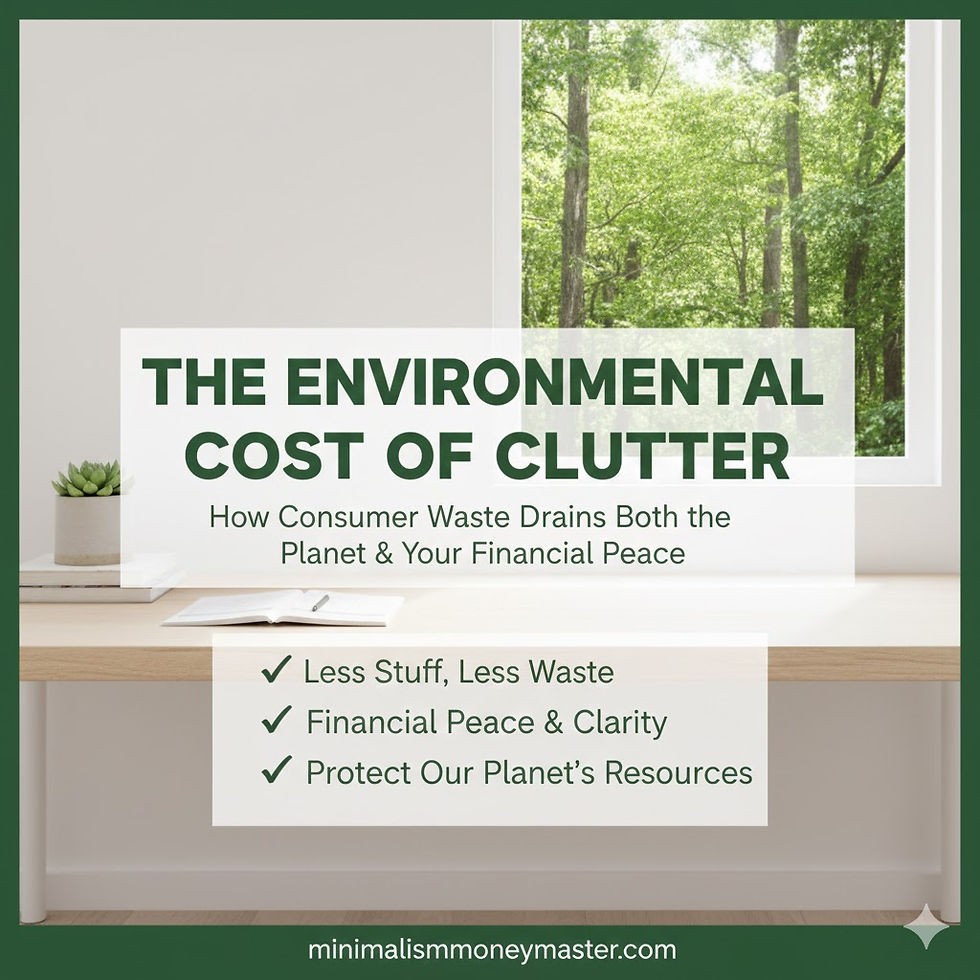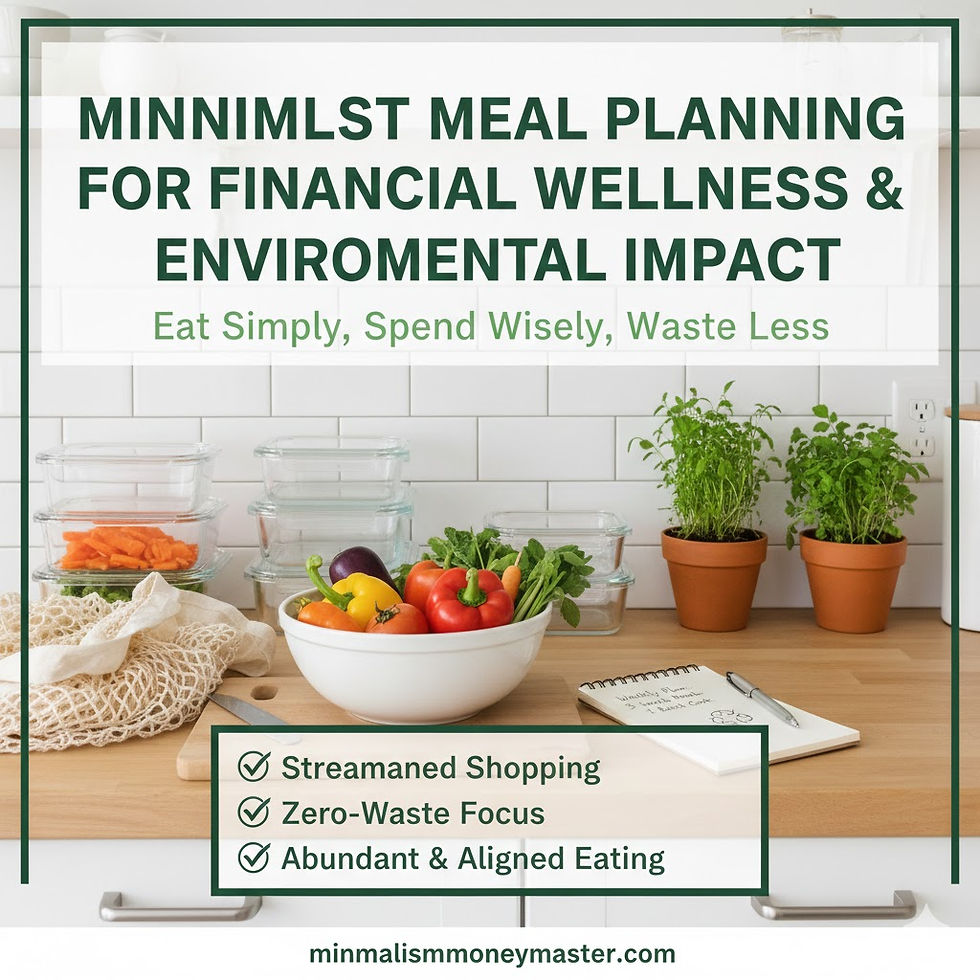Tiny Homes and Financial Freedom: A Minimalist’s Case for Living Small
- jennifercorkum
- Oct 21
- 5 min read
Tiny homes often get portrayed as a quirky movement — Instagram-worthy cabins, mobile micro-houses, or whimsical retreats in the woods. But behind the aesthetics and lifestyle blogs lies something much more powerful: a serious financial strategy.
From a minimalist finance perspective, the tiny home movement isn’t about deprivation or eccentric living. It’s about structuring your housing choices intentionally to reduce financial pressure, accelerate wealth-building, and create flexibility for the long term.
In a world where traditional housing costs keep climbing, tiny homes offer an alternative: smaller spaces, simpler living, and significantly lower expenses — all without sacrificing quality of life when designed well.
This post explores how tiny homes can become a minimalist financial tool, helping you cut through housing market clutter, reduce expenses, and build financial freedom faster.
The Cluttered Housing Market — and Why Minimalism Cuts Through
For most people, housing is the largest single expense in their budget. It’s also the biggest source of long-term financial pressure:
Home prices have skyrocketed in many regions.
Mortgage debt is often measured in decades, not years.
Larger homes mean higher utility bills, property taxes, and maintenance costs.
Cultural expectations push people toward “buying as much house as you can afford” — often leading to lifestyle inflation.
The modern housing market is noisy. It’s filled with oversized floor plans, complicated financing options, and endless add-ons that blur the line between need and want.
Minimalism offers a filter: focus on what actually serves your financial and lifestyle goals, and strip away everything else.
Minimalist finance isn’t about living with nothing — it’s about living intentionally with less financial drag.
Tiny homes apply this philosophy directly to housing. Instead of stretching to afford the biggest home possible, you shrink the structure to what you truly need — and free up financial resources in the process.
Tiny Homes as Cost Reducers
The most obvious advantage of tiny homes is lower cost. But it’s not just the sticker price — it’s the entire financial ecosystem surrounding a smaller space that creates lasting savings.
1. Lower Purchase or Build Cost
Tiny homes typically range between $30,000 and $100,000, depending on design, materials, and location. That’s a fraction of the average home price in many countries.
Some people build their tiny homes themselves for even less. Others choose pre-fabricated models or custom builds, but even the high end often remains well below the cost of a traditional house.
This dramatically reduces (or eliminates) the need for a large mortgage — a key minimalist finance principle. Less debt = more freedom.
2. Lower Utilities and Maintenance
Smaller spaces cost less to heat, cool, furnish, clean, and repair. Energy bills are often 50–80% lower than in conventional homes. Many tiny homes also integrate solar panels, rainwater catchment, or composting toilets, further reducing utility dependence.
Maintenance is simpler and cheaper. Replacing a roof or painting a tiny home costs a fraction of maintaining a 2,000+ square foot house.
These recurring savings compound quietly over time. A few hundred dollars saved each month on utilities, insurance, and upkeep can translate into tens of thousands of dollars invested elsewhere.
3. Lower Property Taxes (in Many Cases)
Depending on how the tiny home is classified (permanent structure, accessory dwelling unit, or mobile home), property tax assessments can be significantly lower. Some tiny homes on wheels or in RV parks may not incur property taxes at all, depending on jurisdiction.
For minimalists, this isn’t about dodging responsibilities — it’s about right-sizing obligations to match real usage and value.
Tiny Homes as Financial Leverage
Tiny homes aren’t just about spending less — they’re about unlocking financial leverage. By dramatically lowering your housing costs, you can redirect money, time, and mental energy toward financial independence, investing, or alternative lifestyle choices.
1. Faster Mortgage Payoff or No Mortgage at All
Many tiny home owners either pay cash upfront or use shorter-term personal loans. Even if financing is needed, the loan is typically far smaller and can be paid off in a few years — not 30.
Imagine being mortgage-free in your 30s or 40s because you chose a $75,000 tiny home over a $400,000 house. The psychological and financial impact is enormous.
2. Increased Savings Rate → Earlier Financial Independence
Housing often consumes 25–40% of household income. By cutting that down drastically, tiny home owners often double or triple their savings rate.
And when you save more, you reach financial independence faster. A household that saves 50–60% of its income can often retire or semi-retire in 10–15 years — a timeline made possible largely by lower housing costs.
3. Flexibility for Location Independence or Semi-Retirement
Tiny homes also offer mobility and flexibility. Many are built on trailers, allowing owners to move with work opportunities, travel, or settle temporarily in lower-cost-of-living areas. Even stationary tiny homes often occupy land that allows creative zoning or co-living arrangements.
This flexibility supports non-traditional work paths, part-time income, travel lifestyles, or simply the ability to live closer to nature without committing to massive property costs.
A Minimalist Framework for Evaluating Tiny Homes
Tiny homes can be powerful financial tools — but only if approached strategically. Minimalism provides a decision-making framework that prevents costly mistakes or romanticized missteps.
1. Clarify Your Financial Goals
Are you aiming for financial independence, lower expenses, or geographic flexibility?
Are you looking for a primary residence, vacation home, or rental income property?
What is your time horizon for ownership?
Clear goals filter out options that look appealing but don’t fit your strategy.
2. Distinguish Romantic Minimalism vs. Strategic Minimalism
Many people fall in love with the idea of tiny homes — cozy cabins in the forest, minimalist aesthetics, Instagram perfection.
Strategic minimalism focuses on numbers, zoning, and long-term costs, not just lifestyle imagery. It asks:
Does this home fit local building codes?
Can it be legally placed where I want to live?
What are the ongoing costs of land, utilities, or maintenance?
What is the exit strategy if my needs change?
3. Consider Legal, Zoning, and Resale Factors
The biggest pitfalls with tiny homes often come from regulation, not construction. Zoning laws, minimum square footage requirements, and land use rules vary widely.
Minimalist planning means doing the research upfront:
Check local zoning laws and permitting requirements.
Investigate utility hookups, off-grid regulations, or RV classifications.
Consider how easy (or hard) it would be to sell or relocate the home later.
Strategic minimalists don’t just build the dream — they build the financial and legal foundation to support it.
Bringing It All Together
Tiny homes are more than a lifestyle trend. From a minimalist finance perspective, they represent a clear, high-leverage way to:
✅ Reduce expenses dramatically across mortgage, utilities, and maintenance.
✅ Increase financial flexibility and savings rate.
✅ Accelerate progress toward financial independence.
✅ Simplify life, focusing resources on what truly matters.
They’re not for everyone — zoning, family size, personal preferences, and mobility needs all matter. But for the right person or couple, a tiny home can function like a financial power tool, turning traditional housing assumptions upside down.
Final Thought
In a world that equates “bigger” with “better,” choosing a tiny home is a radical act of financial clarity. It’s rejecting unnecessary debt and complexity in favor of intentional design, lower costs, and greater freedom.
Tiny homes aren’t about living with less — they’re about living with enough, and freeing your finances to support the life you actually want.







Comments